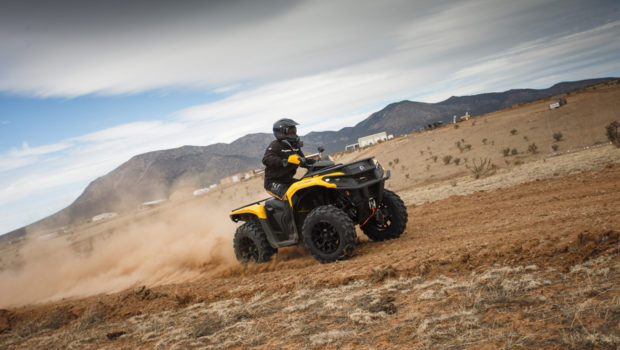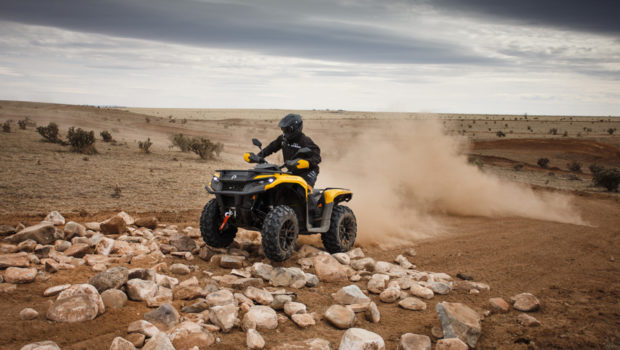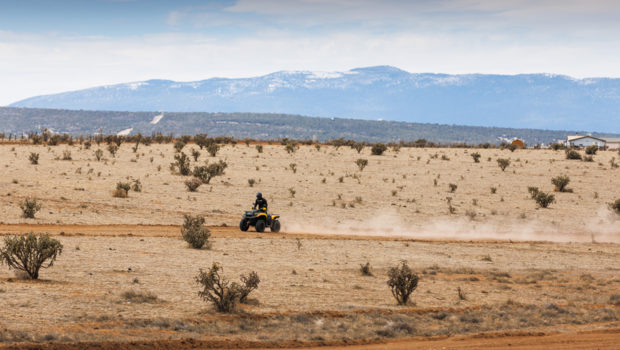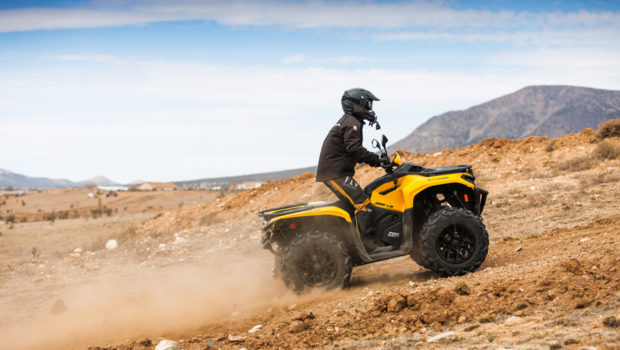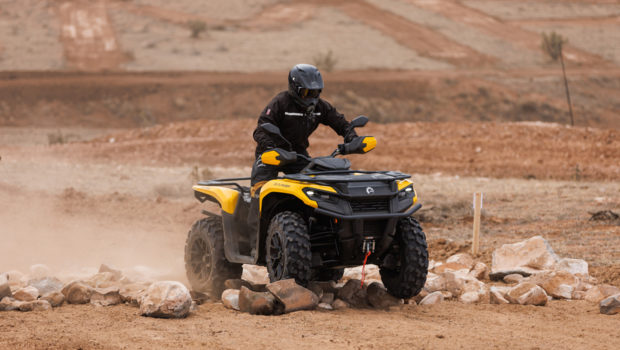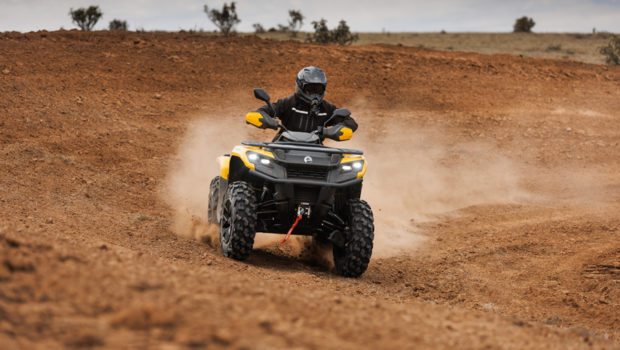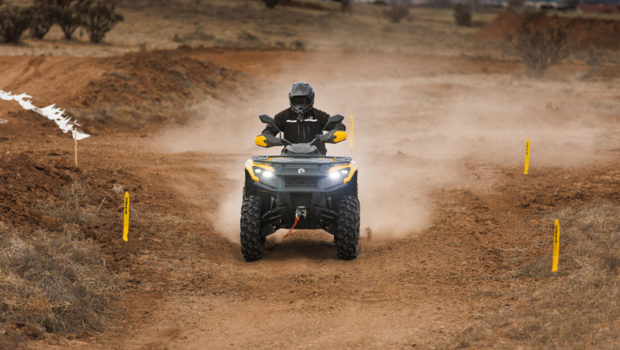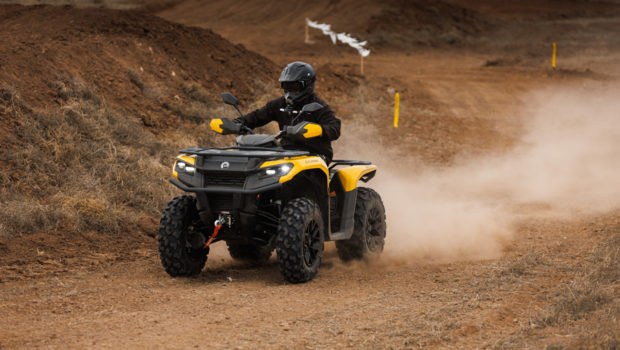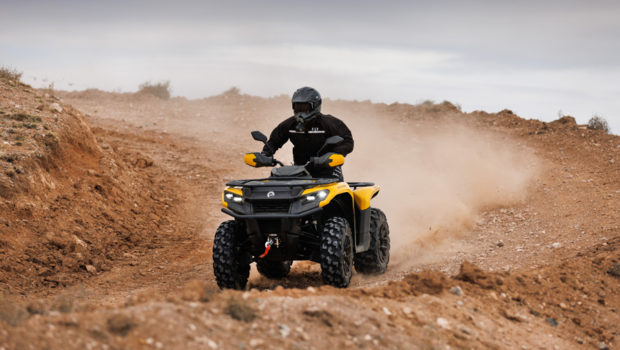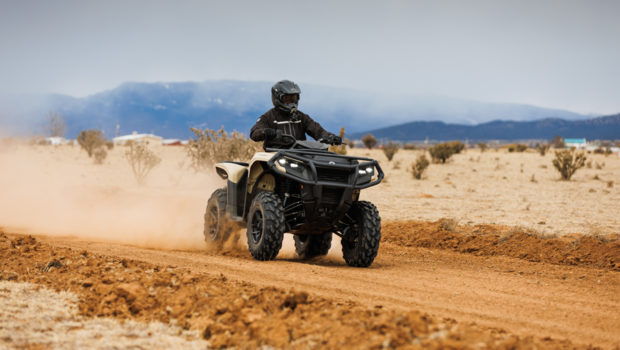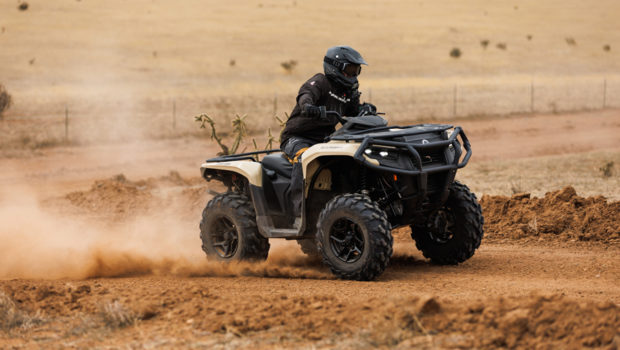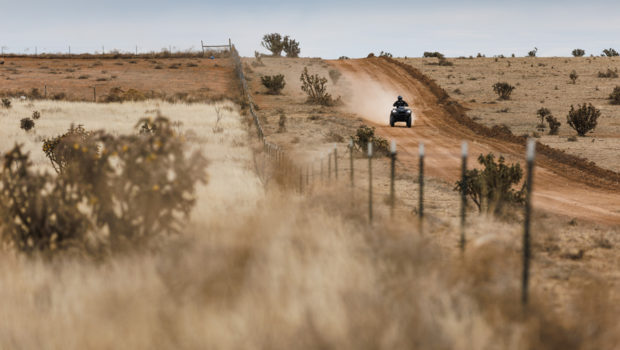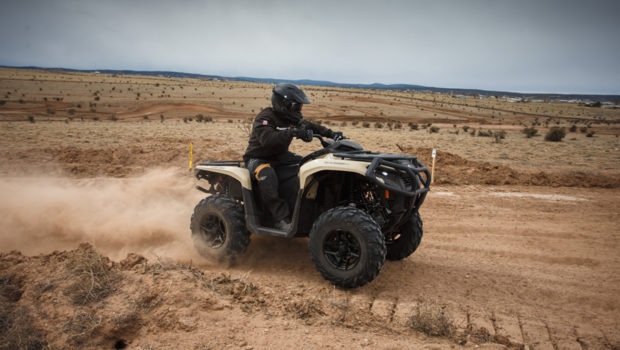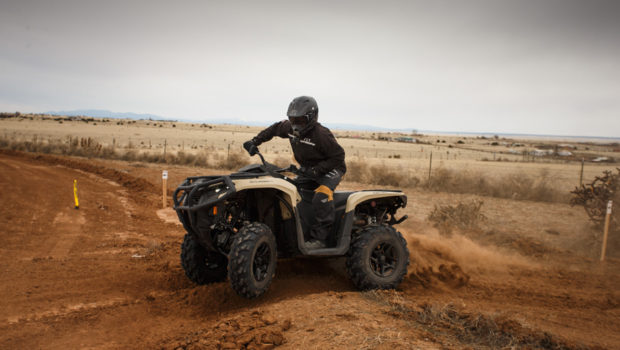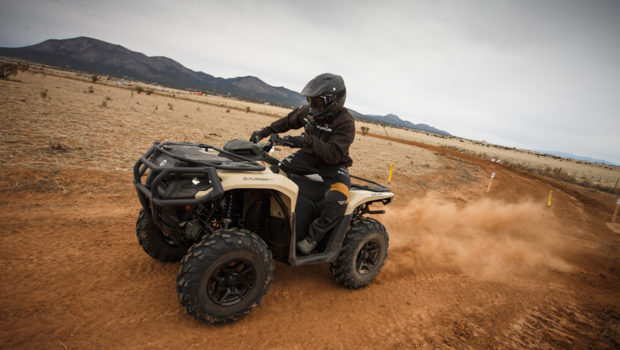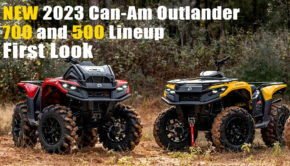Published on April 17th, 2023 | by Joe
2023 Can-Am Outlander 700 and 500 Lineup First Test Review
2023 Can-Am Outlander 700, 500, X MR and HD5 First Test Review:
Built to Take Over the 4×4 ATV Market
Can-Am is replacing their excellent, but aging, Outlander 450 and 570 models, released in 2015, with their brand new sport/utility Outlander 500 and 700, available in both single seat and two-seat Max models. Accompanying them is the Outlander 700 X MR purpose built mud machine, along with the more utility and hunting focused Outlander Pro HD5 and HD7, all available in single-seat configurations only at this time. Can-Am is looking to capture significant market share from the entire single-cylinder 4×4 ATV segment from the 450s to the 570s to the big-bore 700s. By utilizing one chassis and engine throughout the single-seat line with unique engine and suspension tuning for different models, Can-Am’s single-platform design is reintroducing some pretty astounding pricing on brand new machines at a time when MSRPs are going through the roof. Check out our 2023 Can-Am Outlander 700 and 500 First Look Review video for a full breakdown of the different models, features, and pricing of the new Outlanders in detail.
For the first press ride of the new Outlanders, Can-Am flew us out to the BMF ranch in Edgewood New Mexico, owned by Factory Can-Am SXS Racer and one of the winningest fighters in UFC history, Donald Cowboy Cerrone. During our ride, we spent a majority of our time riding their premium recreation model, the Outlander 700 XT 4×4. We rode the base model, 2WD non DPS equipped Outlander 500. We took the 700 X MR for a quick run through the mud along with Factory Can-Am SXS and mud racer, Dustin Jones, and spent a little time getting a feeling for the performance offered by the Outlander Pro HD5.
Mechanical Breakdown
Engine
Evaluating different machines with so much in common, we’ll break down the features and specifications followed by our impressions of the different models. Most of the specifications of the new Outlanders are class leading in nearly every way among 4×4 under 50” in width. Starting with the engine, Outlander 500 or 700, HD5 or HD7 have more to do with expected horsepower and torque for a given class, rather than actual displacement. All of the new Outlanders are powered by a Rotax Ace, 650cc, four-valve, double-overhead-cam, single-cylinder, water cooled, four-stroke engine fed via fuel injection. According to Can-Am, the 500 and HD5 models produce a claimed 40 hp and 37 ft-lb of torque. The 700 and HD7 produce 50 hp and 41 ft-lb of torque, more than any single cylinder 4×4 ATV on the market. Different camshafts and ECU turning yield the difference in performance and price with the 700 and HD7 models costing $800 more than their 500 and HD5 equivalents.
The cylinders are canted rearward with exhausts that exit out the rear of the engine to reduce heat felt by the rider. Full coverage, easily removable side panels were also added all in an effort to further mitigate heat. Pro XU and Hunting models feature drive-by-wire throttles with the HD7s offering Can-Am Intelligent Throttle Control offering work standard and sport modes. While all the Outlanders feature engine braking, all the drive by wire equipped Pro models also feature Can-Am’s selectable 3- mode intelligent engine braking, providing three different levels of engine braking, in addition to their clever speed limiter which allows you to set a maximum top speed for prolonged low speed work duties. Four PRESS Keys can also have speed limitation programmed in to prevent operators from going faster than the owner would like. The other models use cable actuated throttles and standard key switches without all the throttle, speed, and engine braking modes found on the higher end Pro models.
The integrated CVT transmission features Can-Am’s pDrive primary and oversized driven clutch. pDrive features rollers on the primary clutch for smoother engagement, faster backshifts, and reduced maintenance.
Can-Am tells us that although tuning is different, the design of the Outlander’s pDrive transmission is nearly identical to that used in the 200HP Maverick X3 SXS, which should make it pretty bomb proof in an ATV. .CVT calibration is unique between the 500 and HD5, the 700 and HD7 with the HD models designed to run at a slightly lower RPM. The 500 and 700 receive unique calibration due to their different horsepower and torque outputs. The transmission features high and low forward ranges, plus neutral, reverse and park. Pro models and the 700 X MR feature slightly lower gearing in the transmission for their harder working or mud churning intentions. Helical cut gears in the transmission and differentials were used to reduce noise and vibration. The gear selector was designed for smoother shifting.
Intakes for the engine and CVT draw air from high in front of the rider where it’s farthest away from flying dirt and water. Heat exchange inside the transmission is said to have been optimized through computer aided design with the CVT exhaust venting toward the rear of the Outlander, again to minimize heat transfer to the rider. Built to go deep, the intake and CVT vent are mounted even higher on the X MR.
Aside from the 2wd Outlander 500, base model 4×4 models feature Can-Am’s Visto-Lok, auto-locking front differentials that automatically lock the front differential when one front tire starts spinning. DPS models take advantage of Can-Am faster engaging Visto-Lok QE front differential, with power steering there to prevent any unwanted kickback through the steering. Pro XU and Hunting Editions as well as the Outlander 700 X MR benefit from Can-Am Visco-4Lok front differentials providing the benefit of a fully lockable front differential at the flip of a switch.
The materials and design that went into the engine have led Can-Am to recommend maintenance on a yearly basis or every 2000 miles, with the exception of the air filter, of course, leading to a lower cost of ownership . If it were our machine, we’d cut those service intervals in half, at least, but that’s us.
Chassis and Suspension
The new mid-sized Outlanders feature the most suspension travel and ground clearance of any rec/utility ATV under 50” in width. A brand new tubular steel alloy chassis boasts enhanced durability and rigidity while being 35% lighter than the old 450/570 chassis. The entire underside of the frame is protected by a 5.5mm thick HMWPE, plastic skid plate that’s a claimed 40% thicker than the competition. Holes are pre drilled for easy engine maintenance. Can-Am also offers a full line of Plastic and alloy add-on skid plates to further battle harden the machines.
Newly designed front dual A-Arms feature a revised rake for better bump absorption with arched lower Arms for improved ground clearance. Out back Can-Am surprisingly switched from their typical Torsional Trailing Arm design to a Dual A-Arm configuration. Rubber suspension bushings are used throughout to minimize chassis noise and increase durability. Sway bars are used out back to help keep body roll in check.
Compared to the outgoing 450 and 570, most new single-cylinder Outlanders received a 1.25” increase in front suspension travel at 9.75” and a 1.75” increase in rear suspension travel with 10.25” outback controlled by preload adjustable, twin tube, gas charged shocks. The X MR features slightly less travel at 9” front and 9.75” rear to offset its taller 28” tires. The X MR and all DPS models and up on the sport utility side feature Can-Am’s Tri-Mode Dynamic Power Steering along with the XU and Hunting Editions on the Pro models.
New single-seat Outlanders have a 53” wheelbase and measure in between 47.6 and 48.8” in width, with those using 14” wheels appearing to have a bit more wheel offset increasing width. The 2wd Outlander 500 rolls on 25×8” front and 25×10” rear tires mounted on 12” steel wheels delivering 12” of ground clearance. The 700 XT rides slightly more aggressive, 26×8” front and 26×10” rear XPS Trail Force tires mounted on 14” cast aluminum rims providing 12.5” of ground clearance. The X MR rolls on 28×8” front and 28×10” XPS Swamp King tires mounted on 14” cast aluminum wheels providing 13” of ground clearance. All of the utility focused Pro models roll on 6-ply, 26” tires. The HD5 XU we rode features 26×8” front and 26×10” rear XPS Trail King tires mounted on cast aluminum wheels. Its firmer suspension settings result in 13’ of ground clearance for the XU models, ½” more than the 26” equipped Outlander 700 XT. Seat heights are tall ranging between 38 and 38.6”, but these are not the mid-sized 450 and 570. The new Outlanders are full-size machines with extra thick seats that add to the seat height.
Brakes
Hydraulic disc brakes are used at both ends with dual 214mm rotors front and a single 214mm rotor used out back squeezed by dual-piston-calipers at both ends. New metallic brake pads are said to improve durability. The left side handlebar mounted brake lever’s ergonomics were changed in search of improved power and modulation. There is a right side mounted foot brake that operates the rear brake independently.
Utility Capability
Utility Capability is unique with towing and hauling ratings that are leading among all ATVs under 50” in width. Rack capacity is 120lbs front and 240 lbs rear with the 2” hitch receiver rated to tow 1,830 lbs across the lineup, although the X MR’s front rack is taken up by the radiator and snorkels. Based on our initial impression, Can-Am has outdone Polaris with their 9 gallon storage box, which seems sturdier than Polaris’ front rack/carbo box. Plus the lid can be removed providing an open box that sits down inside the front rack’s steel perimeter rack. Out back there’s a steel perimeter rack with an open bed, similar to a scaled down version of what you’d find in the back of a SXS, perfect for sitting a cooler or other items in, rather than trying to strap them down on top of a rack.
As it comes from the factory, we applaud Can-Am for taking a little different approach to on board hauling and storage, offering some unique versatility and capabilities that many buyers will find very attractive; we certainly do. Beyond that, Can-Am has over 75 accessories ready for the new Outlanders with a ton of stackable storage box options front and rear along with a quick attack plow, track system, lights, and windshield/console, perhaps the safest way to bring along a chainsaw, for the rider, saw, and ATV, plus a ton of other accessories. It is perhaps the most customizable ATV on the market when it comes to hauling gear, getting work done, and big outdoor adventures.
Other features
When it comes to the new styling, looks are in the eye of the beholder. One thing everyone should be in agreement on is appreciation for Can-Am’s use of LED lighting front and rear.
Ride Review
Outlander 700 XT
Yours truly handled a majority of our testing duties, assisted by our friend, Matt Lester, from Dirt Trax TV, who was kind enough to ride for some added footage. We highly encourage you to check out their upcoming content on the new Outlanders and we’ll link it up as soon as it goes live.
Hopping aboard the new Outlander 700 XT, we were greeted by the best ergonomics we’ve experienced on a Can-Am sport utility machine. It’s narrower between your knees and smooth down the sides all the way to the foot pegs, without the bulges from the transmission found on their V-twin models. The plastic foot pegs were reasonably sized with ample room in the foot well area. The handlebars and the rest of the controls were well placed, and we really like that Can-Am kept their LED display in front of the handlebars offering more protection and making swapping handlebars easier.
Turn the ignition key, push the brake, and hit the start button- the Outlander fired up without hesitation. Shifting throughout the gated gear selector was smooth in either direction and never hung up like the previous Outlander models can occasionally do. We’ll have to try again on a steep hill to see if it’s perfect, but it certainly seemed improved.
Hitting the test course, the 700’s power delivery was amazingly smooth from bottom to top. We felt that power was a little on the soft side, until we realized that we were riding at 6,300 feet in elevation, costing our test units around 20% of their horsepower. Low-end power is good, but the combination of the altitude, the machine’s rather hefty 858lb dry weight and the seamless experience of the pDrives clutch engagement made the low-end feel a little less impressive than it may actually be under load from a hill or a trailer. We certainly had no trouble bringing the rear end around exiting corners in 2wd proving there’s power on tap. Power builds, pulling hardest in the middle and upper midrange gaining speed respectably. Throttle response was good, and the transmission responded well to throttle input. The engine wasn’t disappointing, but we’d like to ride the 108lb lighter DPS 700 at lower altitude to form a clear opinion on how it stacks up to the other big-bore singles.
Suspension settings and the long wheelbase prevent the pitching and diving under acceleration and braking. This keeps the front tires feeling pretty firmly planted on flat ground, and we suspect it will on steep climbs as well.
Without square edged bumps from roots and rocks, it was hard to fully evaluate suspension performance. The ride felt firm, yet forgiving, of bumps. The edge was taken off holes in the trail surface, and we only bottomed the shocks once very softly, overshooting one of the small tabletop jumps left in our test course. A couple feet of air is no big deal for the shocks. Suspension performance seemed sporty and well rounded, as we’d expect from Can-Am.
In the one tiny rock garden we experienced, the suspension was composed and recovered quickly, keeping you riding high in the travel maximizing ground clearance. We were digging the front of the old 570 into the faces of rolling whoops back in 2015, something we doubt would be an issue on the new Outlanders with their improved approach angles and seemingly more capable suspension.
We quickly forgot about the machine’s tall seat height.. The width, sway bar, and shock settings add up to an ATV that corners nice and flat with little diving and body roll entering turns. If the back end started coming around in 2wd, the long wheelbase kept it from feeling abrupt or unexpected.. At high speeds, the Outlander never felt nervous or twitchy on the flat high-speed straights we tested on.
Power steering calibration might be the best we’ve seen from Can-Am, often using high assist in four-wheel-drive, and mid assist in two-wheel-drive. Steering was light although we’ll need more roots, rocks, and ruts to test its ability to filter bump feedback.
Overall, we feel the chassis and suspension could hold up to a bigger, more powerful, engine than the 700 making the new Outlander 700 feel well planted, manageable, and safer, especially for less experienced riders. We’ve always been fans of having a little more chassis and suspension than motor, allowing us to ride harder while more in control of the machine.
Braking power was good with the single-lever hand brake. Although we used the foot brake from time to time, we didn’t feel it was very necessary. Engine braking was smooth and adequate, without any harsh feeling of engagement or excessive dive of the front end. We also never noticed as much driveline noise under deceleration and braking as we’ve experienced on other machines. Overall, we feel Can-Am delivered on their promise of a relatively quiet machine with little feeling of engine heat, unless we simply sat still for a period of time with the engine running.
By the end of the day, the Outlander 700 XT left us feeling pretty fresh and unfatigued thanks to its smooth engine characteristic, confidence inspiring handling that allowed us to relax, and its well cushioned seat and redesigned ergonomics.
Overall, we came away impressed and wanting more time with the 700 XT to better evaluate it in our neck of the woods. What’s most notable to us is it left us wanting more time with the machine, not necessarily more performance from it. Overall, we came away with a darn good first impression.
Outlander 500 2wd
Next, we threw a leg over the sub $6,000 2wd 500, swapping back and forth between it and the XT 700 for reference. Separated by 10hp but only 4 ft-lb of torque, the 140lb lighter weight 500 seemed nearly as powerful in the bottom third of the RPM range as the 700, which was impressive. Power builds throughout the midrange, but this is where the difference in engine performance between the 500 and 700 shows up with the 700 pulling noticeably harder. It might not beat a 700 in a drag race, but its impressive low-end torque and capable midrange shouldn’t put it far behind when it comes to working or casual riding.
Suspension was nearly identical on the 500 as it was on the 700 with perhaps a touch more bottoming resistance left in reserve due to its lighter weight and reduced power. Handling was again very good and similar to the 700 although the difference in weight felt obvious on the 500 in spite of it not coming equipped with power steering! Can-Am has the base model steering characteristics dialed enough that power steering is a luxury and not seemingly a necessity as we’ve come to view it. Without the benefit of four-wheel-drive to pull you through turns, the 500 did well at going where it was pointed with little hint of pushing or oversteering, further signs that Can-Am did well on nailing down the new Outlander’s handling.
Ergonomics are on par with the top of the line machine in Can-Am’s mid-bore lineup. Braking performance seemed even more impressive on the lighter weight 500.
Pro XU HD5
On day two, Donald Cowboy Cerrone put us to work feeding his animals. We’re sure the bison, turkeys, and other critters at the BMF ranch appreciated the HD5’s relatively quiet operation.
Utilizing the same engine as the Outlander 500 with different clutch calibration to match its working intentions, the HD5 revved a little slower and didn’t backshift quite as quickly as the 500, although it still seemed decently spirited on the trail, especially when you threw in a few S curves.
Three-more Intelligent engine braking is a very cool feature. Switching from minimum to maximum under deceleration, you can really tell the difference in braking power. Minimum is subtle, with max engine braking more substantial, but certainly not harsh when you chop the throttle. The throttle’s speed limiter is perfect for working a food plot, mowing, and plowing.
In spite of the Pro HD’s shocks and 6-ply tires being a little stiffer than the more recreation focused Outlanders, the difference on the trail is small and didn’t leave us feeling beat up. DPS worked well on the HD5 and HD7 as it does on the rec models.
Overall, the Pro HD5 and HD7 bring everything that’s great about using a ride-on ATV for work to the table including their relatively low purchase price, cost of ownership and operation, small storage space and the ability to get big things done on small or large land plots of land. Plus the new Outlander Pro HD line might be the most customizable units of the market for whatever job you have to do. All that, and they’re fun to ride when the work is done.
Outlander 700 X MR
Straight up, we didn’t get much time on the one mud unit they had on hand. Given a few runs through a mud pit after being shown how it’s done by Can-Am Dustin Jones, the 700 did well building some speed heading into the pit and had plenty of power and torque on tap to keep all four wheels spinning with the front differential lock engaged. Editors sent it into the pit repeatedly for around an hour with no signs of coughing or sputtering from water ingestion.
The ride on dry land felt similar to the Pro in terms of how stiff the suspension is, but we truly didn’t have enough time to fully evaluate the machine on dry land as a trail machine for seeking out the deep stuff. Perhaps we will in the future.
Conclusion
We are extremely thrilled with how much ATV Can-Am has delivered for the money. They blew us away with the value of the 450 and 500, later 570, in 2015 and have done it again with the new Outlander 500 and 700 in 2023! Being completely objective, though, these are full size 4×4 chassis ATVs, not the midsize machines they replaced. While they are fast enough, well suspended, excellent handling, and as customizable as a Christmas tree, they are not midsize ATVs and some riders simply want to ride something lighter and more compact. That was one aspect of the outgoing 450 and 570 that’s been lost that we suspect some consumers might want back. Also, the loss when the discontinued Renegade 570 moved the entry level price of a sport 4×4 to a more obtainable level for some who simply may not need more power. We’d certainly like to see a Renegade 700 DPS priced in line or lower than the Outlander XT 7000.
With all that said, from the $5,999 2wd 500 through the $9,799 Outlander XT 700, the $10,199 X MR 700 and the Pro HD lineup, based on our first experience, Can-Am has delivered astounding value for the money with the new mid-bore Outlander lineup. They’re built where they manufacture other high-end units in Mexico, not China, and nothing from the touch points to the riding experience made the new O feel cheap.
Bottom line, Can-Am is delivering newly designed, brand new, 2023 Outlanders at prices that reflect the competition from a few years ago when things were more affordable. And that is a win.

